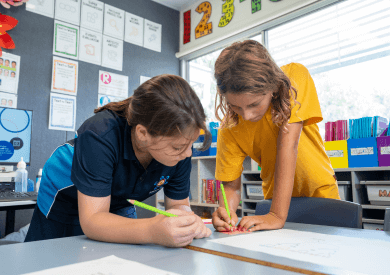Gallery walk
… the gallery walk makes public the work of mathematicians and brings them into dialogue about their thinking... and how they will justify their ideas to a larger mathematical community.
Imm, Fosnot, Dolk, Jacob, & Stylianou 2012, p. 46
In a gallery walk, the teacher asks students to present their mathematical activity using representations, images and symbols (often as a poster), so that other students can see their thinking. Using this recording process gives students a chance to think about which mathematical ideas they want to share, and the most meaningful way to present these ideas for public scrutiny.
The best time to use a gallery walk is after the Explore phase and before the whole class discussion, in the Connect phase of the task. At this point students have just explored the task and their understandings are still fresh in their minds.
Before your students set off on the gallery walk
Encourage students to reflect on their own experience of the task and to focus their attention on the mathematics they may expect to see in the posters. You can prompt students to recall what they have explored during the task, and to view others’ work in light of this.
During the gallery walk
The role of students is that of a critical audience. They move around the classroom like they are in an art gallery, in silence or whispering with a partner. The purpose of this activity is for them to notice how similar or different others’ work is to their own.
As students view and read others’ posters, they record relevant comments and questions about the mathematics onto post-it notes, which they put on the posters.
Your role is to encourage students to take their time to read the work of the other students, as well as remind them to be respectful when they write comments. Students should include positive comments as well as critical ones, and sign their comments to show ownership of them, as members of their class mathematical community.
After the gallery walk
A gallery walk provides time for each student to reflect on and revisit the task. It allows students to see how others approached the problem, as well as providing opportunity for them to make alterations to their own solutions. During the whole class discussion, you can use the post-it notes as a source of student feedback to explore your students’ mathematical thinking more deeply and call upon individuals to clarify their comments.
A gallery walk is not show-and-tell
It is important to note that a gallery walk is not a ‘show-and-tell’ activity, for students to simply share their work and comment on how it looks! The gallery walk is a tool which gives all students the opportunity to critically view and review their class’s mathematical activity. In real life, mathematicians share their work with the mathematical community through conferences and publishing in mathematical journals. The gallery walk is an engaging opportunity for students to be mathematicians together.
Discuss with your colleagues
- What is something that stands out for you in the gallery walk? Why?
- How is a gallery walk different to a ‘show and tell’ activity?
References
Fosnot, C. T., & Jacob, B. (2010). Young Mathematicians at Work: Constructing Algebra. National Council of Teachers of Mathematics. 1906 Association Drive, Reston, VA 20191-1502.
Imm, K. L., Fosnot, C. T., Dolk, M., Jacob, B., & Stylianou, D. (2012). Learning to support young mathematicians at work: An early algebra resource for professional development. Heinemann.
Fishbowl
Fishbowls feature a small interior circle of participants surrounded by a larger outside circle of participants. While the inside group of participants engage in a discussion, the outside group is free to listen and to share questions with classmates standing beside them.
Hamilton 2023
The Fishbowl activity provides an opportunity for students to learn from each other as they observe and notice other students engaging in a task.
The teacher divides students into two groups: those observing and those doing the task. Those students who are observing stand form a circle, or fishbowl, around the small group who continue to work on the task. The students who are observing actively watch and listen, and only share questions with those standing next to them. You may provide some prompts to focus their observations.
A discussion should be held at the end of the task or observation period for students to reflect on what they observed, and to provide opportunity for the students doing the task to respond to questions and comments so that their thinking and strategies are clearly understood by all.
Discuss with your colleagues
- What opportunities does this activity offer students?
- What other activities do you use which perform the same role, with your students?
References
Hamilton, D. (2023). Exploring Qualitative and Quantitative Approaches to Inquiry through Fishbowl Role Plays. Active Learning for Real-World Inquiry.

